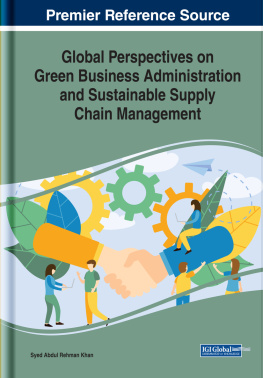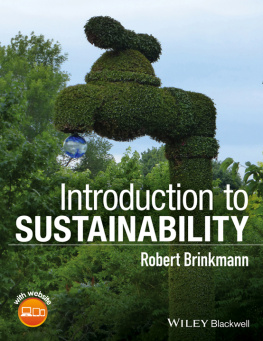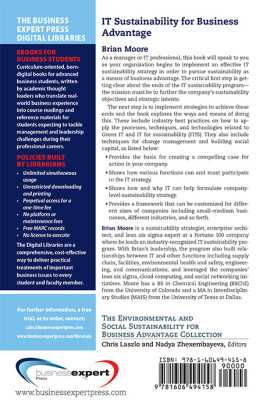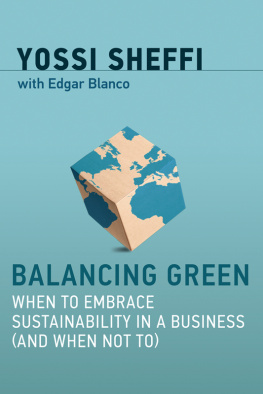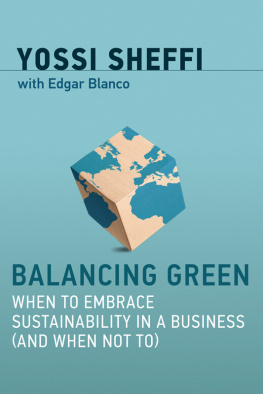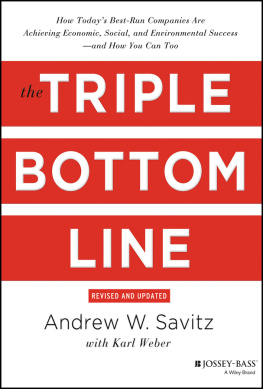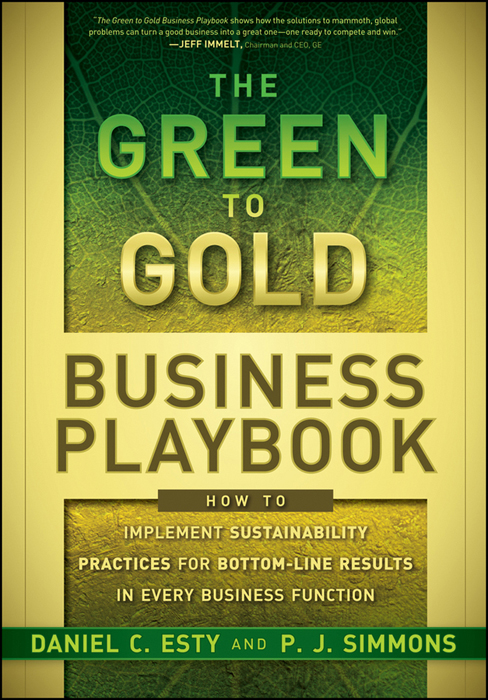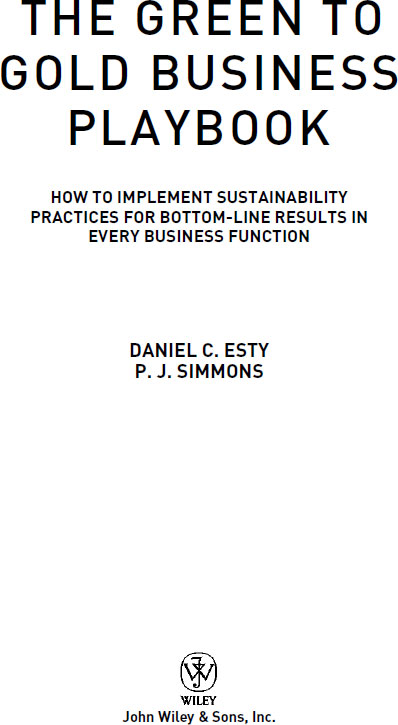This book is printed on acid-free paper made from 100 percent post-consumer recycled pulp with soy ink. 
Copyright 2011 by Daniel C. Esty and P. J. Simmons. All rights reserved.
Published by John Wiley & Sons, Inc., Hoboken, New Jersey.
Published simultaneously in Canada.
No part of this publication may be reproduced, stored in a retrieval system, or transmitted in any form or by any means, electronic, mechanical, photocopying, recording, scanning, or otherwise, except as permitted under Section 107 or 108 of the 1976 United States Copyright Act, without either the prior written permission of the Publisher, or authorization through payment of the appropriate per-copy fee to the Copyright Clearance Center, Inc., 222 Rosewood Drive, Danvers, MA 01923, (978) 750-8400, fax (978) 646-8600, or on the web at www.copyright.com . Requests to the Publisher for permission should be addressed to the Permissions Department, John Wiley & Sons, Inc., 111 River Street, Hoboken, NJ 07030, (201) 748-6011, fax (201) 748-6008, or online at http://www.wiley.com/go/permissions .
Limit of Liability/Disclaimer of Warranty: While the publisher and author have used their best efforts in preparing this book, they make no representations or warranties with respect to the accuracy or completeness of the contents of this book and specifically disclaim any implied warranties of merchantability or fitness for a particular purpose. No warranty may be created or extended by sales representatives or written sales materials. The advice and strategies contained herein may not be suitable for your situation. You should consult with a professional where appropriate. Neither the publisher nor author shall be liable for any loss of profit or any other commercial damages, including but not limited to special, incidental, consequential, or other damages.
For general information on our other products and services or for technical support, please contact our Customer Care Department within the United States at (800) 762-2974, outside the United States at (317) 572-3993 or fax (317) 572-4002.
Wiley also publishes its books in a variety of electronic formats. Some content that appears in print may not be available in electronic books. For more information about Wiley products, visit our web site at www.wiley.com .
Library of Congress Cataloging-in-Publication Data:
Esty, Daniel, 1959
The green to gold business playbook : how to implement sustainability practices for bottom-line results in every business function / Daniel Esty, P.J. Simmons.
p. cm.
Includes index.
ISBN 978-0-470-59075-1(cloth); ISBN 978-1-118-01072-3 (ebk); ISBN 978-1-118-01088-4 (ebk); ISBN 978-1-118-01089-1 (ebk)
1. Industrial managementEnvironmental aspects. 2. CorporationsEnvironmental aspects. 3. Business enterprisesEnvironmental aspects. I. Simmons, P. J.,1967 II. Title.
HD30.255.E883 2011
658.4083dc
222010042187
The authors have offset the greenhouse gas emissions associated with the printing and distribution of this book through the purchase of carbon reduction credits from San Franciscobased 3Degrees Group, Inc. 3Degrees, a leading carbon offset provider, is supplying offsets from a landfill gas capture and electric energy generation project in Denton, Texas. All carbon offsets generated will be registered and verified by the Climate Action Reserves Landfill Project Protocol.
To our parents
John and Katharine Esty
Patrica Bonin and E. Joseph Simmons, Jr.
Preface
When we set out to write Green to Gold: How Smart Companies Use Environmental Strategy to Innovate, Create Value, and Build Competitive Advantage , very few people in the business world were focused on environmental issues or broader sustainability concerns as a core element of strategy. But in the intervening years, in part spurred on by Green to Gold , many business leaders have come to recognize the importance of climate change, water, air pollution, waste management, land use, chemical exposures, food safety, and other environmental issues to marketplace success. Companies face evolving regulatory requirements, natural resource scarcities, shifting consumer expectations, rising demands from business customers who are greening their supply chains, and other sustainability pressures that shape the nature of competition.
Interest in green business has expanded considerably. Top executives in almost every large corporation now recognize that the environment and sustainability issues must be part of their business strategies. Leaders of mid-sized and even small companies increasingly find value in applying an environmental lens to their business activities. The number of entrepreneurs launching companies designed to sell environmental goods and services or traditional products with an environmental twist has expanded exponentially. Almost every city now offers green dry cleaners, green lawn care services, green printers, and green versions of many other day-to-day products and services.
Of course, interest in the environment generally and a focus on bringing green thinking into the business domain does not proceed in a linear fashion. Over the last several years, the significant worldwide economic downturn has caused some companies to pull back on their sustainability focusand inspired Andrew to write Green Recovery (Harvard Business Press, 2009), which reformulated the green business case for tight times.
We were not surprised by this flow following the ebb of the green tide. But we were impressed by how many companies maintained, or even accelerated, their commitment to going green through the downturn, and how many others quickly reestablished sustainability as a priority as the recovery kicked in. The sustained interest in corporate environmental strategy should not, however, have come as a surprise. Eco-efficiencythe use of an environmental lens to look for opportunities to eliminate waste and inefficiencyhas special value in a downturn. Lower energy consumption, reduced scrap, and more efficient use of every input in a production process cuts costs, and those savings drop straight to the bottom line.
Environmental activities are also a popular way to maintain employee morale during difficult times. Companies in many sectors and countries are ramping up their sustainability activities as a way to demonstrate to their workforce a commitment to corporate social responsibility and to being an attractive employer over the long termeven as layoffs and other cuts occur.
The quick reemergence of the environment and sustainability as central corporate strategy agenda items does not mean that interest in the environment and the societal commitment to respond to these challenges has been strengthened across all issues and in all places. Quite to the contrary, the United States seems to have broken down in its ability to address climate change in a thoughtful and serious manner. Moreover, significant uncertainties remain about the best path forward with regard to chemical exposures, waste, packaging, and many other concerns. And companies find themselves facing new challenges, evolving science, and changing public perceptions about what needs to be addressed and~how.
The Green to Gold Business Playbook , which Dan wrote with P.J. Simmons, seeks to respond to these questions, building on the foundation laid in the original Green to Gold. This new book offers clear and pragmatic guidance on how to bring sustainability into each and every business function in a manner that delivers tangible results. Green to Gold reached many more people than we could ever have dreamed of, but many of the executives that have used it as a strategic template have asked us how to drive that kind of thinking into all aspects of the company. We are pleased to see the work that we started going in so many directions. We hope this new book will serve as a worthy companion to and extension of the strategies and tools weve already offered.



